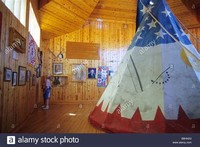Facts about Crazy Horse

Little Big Man claimed that the camp Commander suggested the story of the guard being responsible for Crazy Horse's death as a means of hiding Little Big Man's involvement and thereby avoiding inter-clan reprisals.
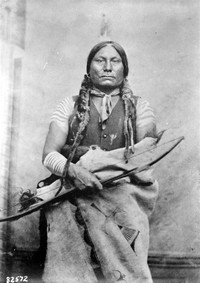
Warriors led by Chief Gall led the main body of the attack, and once again Crazy Horse's role in the battle remains uncertain.
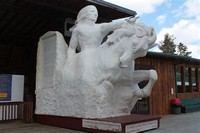
Several elders convinced Crazy Horse and No Water that no more blood should be shed, and as compensation for the shooting, No Water gave Crazy Horse three horses.

Just outside the door of the guardhouse, Crazy Horse was stabbed with a bayonet by one of the members of the guard.

On the morning of September 5, 1877, Crazy Horse and Lee, accompanied by Touch the Clouds and a number of Indian scouts, departed for Camp Robinson.

Lee turned the Oglala war chief over to Captain James Kennington, in charge of the post guard, who accompanied Crazy Horse to the post guardhouse.

Little Big Man, standing immediately behind Crazy Horse and not wanting the soldiers to have any excuse to kill him, seized Crazy Horse by both elbows, pulling his arms up and behind him.

When Crazy Horse saw that Black Buffalo Woman cared for him, he decided to make her his wife.

Little Big Man's account claims that, as Crazy Horse was being escorted to the guardhouse, he suddenly pulled two knives from under his blanket, one in each hand.
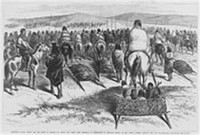
Crook ordered Crazy Horse arrested and then departed, leaving the military action to the post commander at Camp Robinson, Lt. Col. Luther P. Bradley.

Crazy Horse's vision first took him to the South, the Lakota direction of death.

The following morning, Crazy Horse's body was turned over to his elderly parents who took it to Camp Sheridan, placing it on a scaffold there.

The attention that Crazy Horse received from the Army elicited the jealousy of Red Cloud and Spotted Tail, two Lakota chiefs who had long before come to the agencies.

Crazy Horse was born in 1840, with sources conflicting as to whether this was in the fall or the spring.
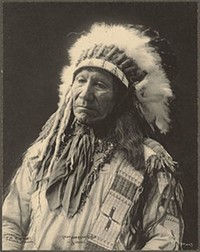
Some Native American activists, most notably Russell Means, have criticized the project as exploitive of Lakota culture and Crazy Horse's memory.

When the War Department ordered all Lakota bands onto reservations in 1876, Crazy Horse became a resistance leader.

On August 2, 1867, Crazy Horse participated in the Wagon Box Fight near Fort Phil Kearny.

Bourke's version is based on a personal interview with Little Big Man, who was present at Crazy Horse's arrest and wounding.
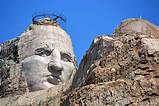
Led to a guardhouse, Crazy Horse began to struggle, but how he actually died remains a controversy due to conflicting eyewitness accounts.

On May 5, 1877, knowing that his people were weakened by cold and hunger, Crazy Horse surrendered to United States troops at Camp Robinson in Nebraska.

One of Crazy Horse's animal protectors would be the white owl, which according to Lakota tradition would give extended life.

A definitive article on its authenticity or lack thereof was published in Whispering Wind Magazine, Vol 34 # 3, "Debating the Crazy Horse Photo" by Jack Heriard.

Rumors started to spread about Crazy Horse's desire to slip out of the agency and return to the old ways.

The official version is that, once inside, Crazy Horse struggled with the guard and Little Big Man and attempted to escape.

On January 8, 1877, Crazy Horse's warriors fought their last major engagement, the Battle of Wolf Mountain, with the United States Cavalry in the Montana Territory.

The moths Noctuidae have a hearing organ called a tympanum that responds to an incoming bat signal by causing the moth's flight muscles to twitch erratically, sending the moth into random evasive maneuvers.
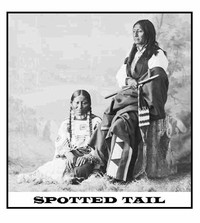
The following month when the Spotted Tail Agency was moved to the Missouri River, Crazy Horse's parents moved the body to an undisclosed location possibly somewhere on the present Pine Ridge Reservation.

The doctor who attended at Crazy Horse's death, however, stated that it was certainly not a photograph of him.

John Gregory Bourke's memoir of his service in the Indian wars, On the Border with Crook, however, details an entirely different account of Crazy Horse's death.

Crazy Horse (Lakota: Thaљ?ka Witko, literally "his-horse is-crazy"), ca.

No Water was away from camp when Crazy Horse and Black Buffalo Woman took off on their trip.

When Crazy Horse answered, he stuck a pistol into the tipi and aimed for Crazy Horse's heart.

Led to a guardhouse, Crazy Horse began to struggle, but how he actually died remains a controversy due to conflicting eyewitness accounts.

Through the late 1850s and early 1860s, Crazy Horse's reputation as a warrior grew.

Crazy Horse and his followers attempted to rescue the camp and its headman, (Old Man) American Horse.

Rumors started to spread about Crazy Horse's desire to slip out of the agency and return to the old ways.

